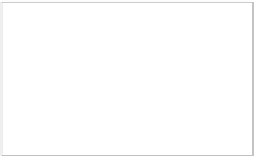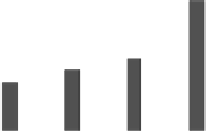Biomedical Engineering Reference
In-Depth Information
For quantitative measurement of porosity, we determined to use
following equation:
Porosity(%) = (
S
PLCL
-
S
d
)/
S
PLCL
×
100
(8.2)
where
S
d
is the density of PLCL scaffolds and
S
PLCL
is the density
of nonporous PLCL polymer, which was 1.43
g/cm
3
at 26
°
C. This
evaluation method of porosity is quite simple but very reliable in
terms of using three-dimensional information of scaffolds (volume
and weight).
To calculate the density, it is necessary to calculate the volume
of scaffold. First, we measured the wall thickness of each scaffold
by an optical microscope. Figure 8.10 shows the distribution of wall
thickness at three parts of scaffold. The thickness was measured at
four different points and averaged (
n
= 4). The tendency of thicker
wall at higher concentration of sodium chloride was conirmed. The
wall thickness changed from 300
μ
m to 800
μ
m in these conditions.
The average wall thickness was used to calculate the volume of 12
samples (3 parts
×
4 compositions).
After the measurement of scaffold volume and weight, we
calculated the density of each scaffold at three different parts
(parts A, B, and C in Fig. 8.8). Figure 8.10 shows the distribution of
porosity at four different polymer composition and three different
parts. Good correlation of higher porosity at higher concentration of
sodium chloride was conirmed. Porosity changed from 5% to 40%
as the NaCl ratio increased. The deviation of porosity depending on
parts was less than 15% (NaCl : PLCL = 6 : 4).
60
1000
Part A
Part B
Part C
Part A
Part B
Part C
50
800
40
600
30
400
20
200
10
0
0
2:8
4:6 6:4
8:2
Weight percent ratio of NaCl : PLCL
2:8
4:6
6:4
8:2
Weight percent ratio of NaCl : PLCL
Figure 8.10
(Left) Relation between porosity and wall thickness at three
parts. (Right) Variation of porosity according to the increase of
NaCl ratio to polymer.


















































































Search WWH ::

Custom Search